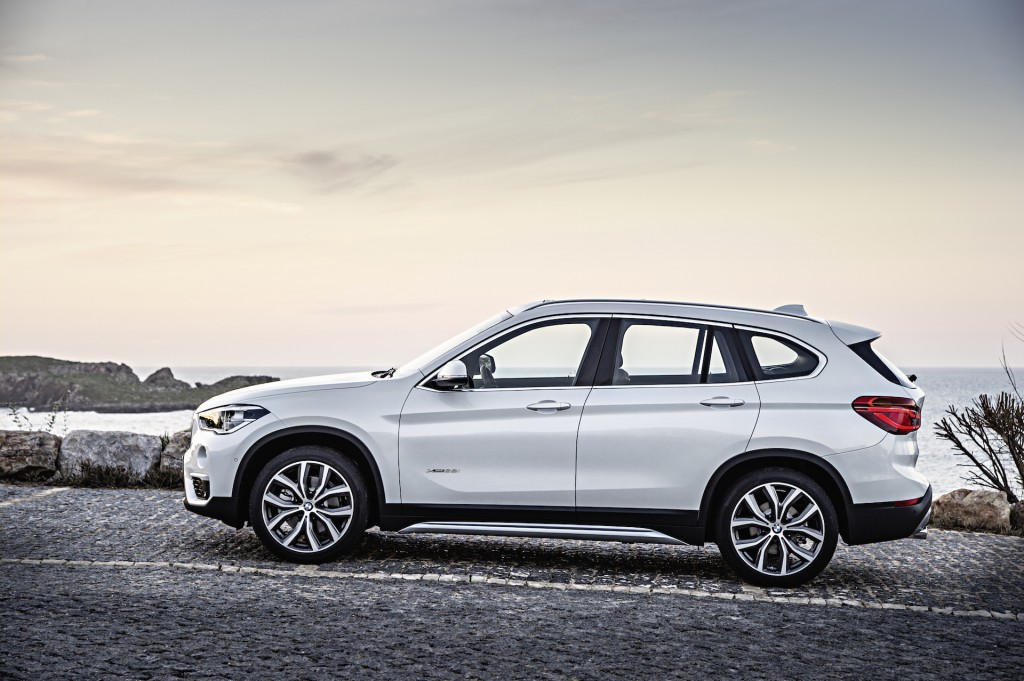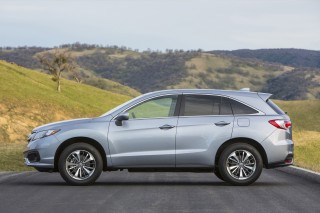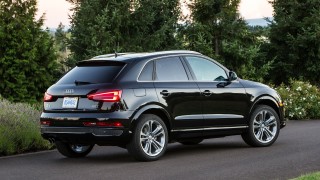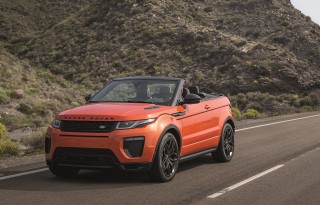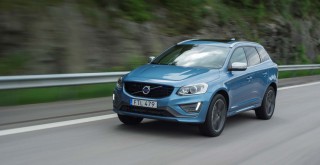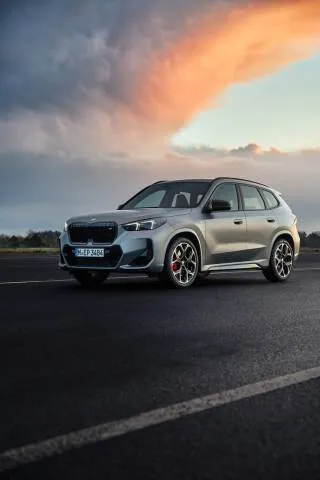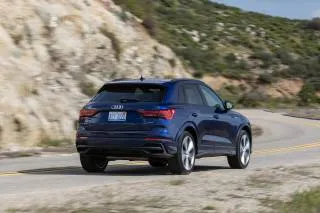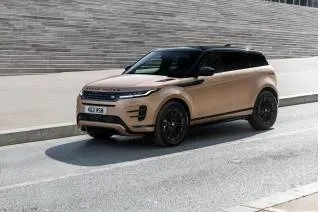Likes
- Crossover utility
- Gutsy turbo 4-cylinder
- Good rear-seat space
- Fairly thrifty fuel economy
- Competitive price of entry
Dislikes
- Prices climb quickly with options
- Some cost-cutting in interior trim
- Driver assists cost extra
- Poor front seats
Buying tip
features & specs
Pleasant to drive and built to a price, the 2017 BMW X1 is a mainstream subcompact crossover that is pleasant to drive but lacks the brand's "ultimate driving machine" performance.
The 2017 BMW X1 sits apart from other BMWs. With its front-wheel-drive, Mini-sourced platform, is the brand's entry-level subcompact crossover and a more mainstream, less passionate vehicle than you would expect from BMW. It is offered as the front-drive sDrive28i and the all-wheel-drive xDrive28i, the former added for 2017.
We give it a 6.2 out of 10, with points added for its decent interior space, peppy turbocharged 4-cylinder engine, and excellent crash test performance. (Read more about how we rate cars.)
Styling and performance
The X1 looks a little bigger than it is. It puts an emphasis on height, and the shape of the greenhouse helps it read more as a crossover than a wagon. The details are pure BMW with the twin kidney grille up front, cat's eye headlights and taillights set high in the corners, and some nice sculpting along the body sides.
Inside, the X1 has a smart look. The dashboard styling is au courant, particularly with the optional, 8.8-inch touchscreen mounted atop a center console that's festooned with much-appreciated buttons for audio and climate systems.
The BMW X1 comes in with just one engine, a turbocharged 2.0-liter inline-4 that makes 228 horsepower and 258 pound-feet of torque. It is paired with an 8-speed automatic transmission. The 2.0 provides excellent straight-line acceleration and strong passing power when you need it. BMW claims 0-to-60 mph acceleration of 6.4 seconds, and that feels about right to us.
Fuel economy is fairly good at 23 mpg city, 32 highway, 26 combined with front drive and 22/31/25 mpg with AWD.
The fact that the X1 barely qualifies as a crossover works in the favor of its on-road performance. It rides comfortably on its standard 18-inch wheels with run-flat all-season tires. The electric speed-sensitive steering is quick and well weighted, but it lacks some of the feel you'd expect in a BMW. Braking is good, and you can hustle the X1 through corners at un-crossover-like speeds.
While the handling is pleasant, it's certainly not inspiring. With its front drive layout, you could take the badges off and X1 and easily mistake it for a Ford or Kia from behind the wheel. We're not saying that's bad; this vehicle just isn't special.
Interior, safety, and features
The 2017 BMW X1 is built to an aggressive price, and while none of the interior materials look or feel cheap, some look and feel cheaper than you might expect in a premium vehicle.
We're impressed by the available matte-finish wood trim and contrasting stitching, but we aren't enamored with the front seats. They’re woefully inadequate in thigh bolstering, and thin on back support. The back seats may actually be more comfortable. The rear seat has good leg room, but it’s a quite narrow vehicle so don’t count on fitting three across.
Oddly, the fully adjustable, reclining and sliding-fore-and-aft rear seat arrangement is a $300 option. We can’t imagine why you wouldn’t want it and its five inches of travel.
Cargo space is good for the subcompact class, but less than you'd get in a mainstream compact crossover.
BMW defines the X1's segment narrowly, with a handful of upscale niche competitors like the Range Rover Evoque and Audi Q3. In reality, though, with a starting price in the mid-$30,000s, the X1 faces a startling array of premium competitors like the Acura RDX and Volvo XC60, and—perhaps—even highly optioned mainstream alternatives like the Ford Escape Titanium.
Some of those competitors might look more attractive when compared on a feature-for-feature basis.
BMW builds the X1 to an aggressive price and standard equipment tends to be sparse. When notable features on a base-spec upscale vehicle include unremarkable amenities like power front seats and imitation leather, you know you'll be spending a least a few thousand dollars on options to bring it up to the luxury level.
With the right packages—Luxury, Premium, and Technology—an X1 can feel almost lavish. The Luxury package brings leather seats and wood or aluminum trim; you can add features like a panoramic roof and LED headlights with the Premium package; and the Technology package adds extras like navigation and a head-up display. An M Sport package has a sport-tuned transmission and suspension, sport seats, and a body kit.
Be careful what options you pick, though, as X1 pricing can move into the territory of more luxurious vehicles.
Oddly, a rearview camera is one of those options (though adaptive cruise control is standard). It comes in a package with front and rear obstacle detection and a self parking system. Buyers can also get lane departure warning, forward collision warnings, pedestrian detection with low speed braking, and automatic high beams. Unfortunately, all of these systems are optional.
Crash test ratings are not complete yet, but the X1 has earned a Top Safety Pick rating from the IIHS.
2017 BMW X1 Styling
The 2017 BMW X1 has classic crossover looks, with a simple but attractive interior.
The 2017 BMW X1 has its work cut out for it in the image department. As a front-drive-based vehicle BMW purists will dismiss it out of hand, but it still has to appeal to the masses—a mission made possible by its mid-$30,000s pricing.
The X1 looks a little bigger than it is; it is, after all, based on a Mini platform. The looks are in line with modern crossover SUVs. It puts an emphasis on height, and the shape of the greenhouse helps it read more as a crossover than a wagon.
Otherwise, the details are pure BMW. The twin kidney grille resides up front with the cat's eye headlights and taillights set high in the corners. There is some nice sculpting along the body sides, and the lower body sides have a dark cladding that wraps around the rear and plays off the lower air intakes up front.
The interior has a smart look. Dashboard styling is au courant, particularly with an optional, 8.8-inch touchscreen mounted atop a center console that's festooned with much-appreciated buttons for audio and climate systems. The large screen comes with a touchpad controller on top of BMW's iDrive twist-push knob. The instrument panel has big, round analog gauges, supplemented by a head-up display, you can get just the right amount of information right in the line of sight.
In our new ratings system, we give the X1 a 6, awarding the exterior a point for BMW's attractive design. (Read more about how we rate cars.)
2017 BMW X1 Performance
With it's front-drive-based platform, the X1 doesn't handle like a classic BMW, but the turbocharged 4-cylinder engine is peppy.
The 2017 BMW X1 comes with just one engine, a turbocharged, direct-injected 2.0-liter inline-4 rated for 228 horsepower and 258 pound-feet of torque. It's mated to an 8-speed automatic transmission with and paddle shifters. The 2.0 provides excellent straight-line acceleration and strong passing power when you need it. BMW claims 0-to-60 mph acceleration of 6.4 seconds, and that feels about right to us.
The engine is the strength of the X1 and it earns the point that raises performance to a 6. (Read more about how we rate cars.)
Through Driving Dynamic Control, you can bring up Sport, Comfort, and Eco Pro modes, which change the calibration of the electric power steering, accelerator sensitivity, and shift behavior/points. While the lack of a Sport+ mode is pretty telling about BMW’s intent with this model, we found a wider range than usual between these three settings—especially in powertrain respects. Quick transitional bursts of power are painfully hesitant in Eco Pro, and even Comfort mode sometimes, yet they’re a lot sharper in Sport or if you shift over to the manual-control shift gate. We found that the transmission stubbornly resists downshifting during uphill acceleration from low speeds with moderate throttle, but flipping into Sport mode solves that problem.
The fact that the X1 barely qualifies as a crossover works in the favor of its on-road performance. Electric speed-sensitive steering is quick and well weighted, but it lacks some of the feel you'd expect in a BMW. Braking is good, and you can hustle the X1 through corners at un-crossover-like speeds.
The X1 rides comfortably on its standard 18-inch wheels with run-flat all-season tires. Conventional all-season tires with a space-saver spare are a no-cost option; 19-inch wheels with run-flat performance tires cost extra. We haven't tested the stiffer M Sport yet, and it my be too firm for some tastes.
While the handling is pleasant, it's certainly not inspiring. With its front-drive layout, you could take the badges off an X1 and easily mistake it for a Ford or Kia from behind the wheel. We're not saying that's bad; this vehicle just isn't special.
The X1 offers all-wheel drive, or xDrive as BMW calls it, which uses a multi-plate clutch and hydraulic pump system to send up to 100 percent of engine power to the rear wheels when needed—in less than a quarter of a second. A test drive along mountain roads beset by detritus from a series of landslides gave the X1 a chance to demonstrate its SUV-lite capabilities. Good ground clearance proved especially useful in this approximation of real-world obstacles an X1 owner might actually encounter. We did lose traction, though, in a few gravel-strewn apexes taken at speeds that seemed reasonable, and this somewhat diminished our confidence.
2017 BMW X1 Comfort & Quality
The front seats are flat and formless, but the passenger space is good for four and the X1 offers more utility than most class rivals.
The 2017 BMW X1 is built to an aggressive price, and while none of the interior materials look or feel cheap, some look and feel cheaper than you might expect in a premium vehicle.
We were impressed by the matte-finish wood trim and contrasting stitching in our test car. The dash is close to what you’ll see in other BMW models by layout, yet it’s positioned in an entirely different place relative to the front occupants—lower, which combined with the relatively thin pillars, affords you a pretty great view around.
We aren't enamored with the front seats. They’re woefully inadequate in thigh bolstering, and focused all the pressure on butts in a way that might be fine in a short-distance electric car, but not in a vehicle some might occasionally take cross-country. Back support is also thinner than we’ve encountered in other BMWs. We haven't tried the sport seats, but they have to be better than the base seats.
The back seats may actually be more comfortable. No joke; they’re easy to get into, thanks to generous door cuts. It’s a quite narrow vehicle so don’t count on fitting three across.
Oddly, the fully adjustable, reclining and sliding-fore-and-aft rear seat arrangement is a $300 option. We can’t imagine why you wouldn’t want it and its five inches of travel.
Space isn't really a problem, though. There's plenty of head room all around, and surprisingly generous leg room for rear passengers. Width is, however, in somewhat short supply and three adults won't want to spend much time in back.
Cargo space is 27.1 cubic feet with the rear seat up and 58.7 cubic feet with the rear seat folded. That's better than an Audi Q3 or Range Rover Evoque, but far short of the room you'd get in a mainstream larger compact crossovers like the Honda CR-V or Toyota RAV4.
We give the X1 a 6 for quality and comfort, giving it points for rear seat space and cargo space, but subtracting a point for the front seats. (Read more about how we rate cars.)
2017 BMW X1 Safety
Initial safety scores are good and BMW offers plenty of safety features, but a rearview camera is an option.
The 2017 BMW X1 comes all the usual airbags and federally mandated safety systems. It also comes standard with adaptive cruise control, but, oddly, a rearview camera is optional.
BMW offers a pair of Driver Assistance packages. The base version adds a rearview camera, front and rear obstacle detection, and a parking assistant that surveys parking spots on either side of the road to determine if the X1 will fit into them, then steers the vehicle into place. The Driver Assistance Plus package adds lane departure warning, forward collision warnings, pedestrian detection with low speed braking, automatic high beams, and speed limit information.
Federal safety officials haven't tested the X1 yet, but the IIHS has tested the 2017 model. In IIHS testing, it earned the top score of "Good" in all tests and an "Advanced" rating for its front crash prevention system, earning it the Top Safety Pick honor. Only an incomplete test of its headlights stands between the small X1 and the big Top Safety Pick+ award.
The X1 gets a 6 for safety due to its IIHS ratings. (Read more about how we rate cars.)
2017 BMW X1 Features
BMW makes quite a few appealing features available, but they raise the price to more luxurious territory.
With a starting price in the mid-$30,000s, the 2017 BMW X1 isn't lavishly equipped in base form. Both the front-drive sDrive28i and all-wheel-drive xDrive28i come with the same features, aside from the all-wheel-drive system.
Those standard features include leather-like SensaTec (synthetic) upholstery, a leather-wrapped steering wheel, automatic climate control, a power liftgate, roof rails, fog lights, automatic headlights, adaptive cruise control, an AM/FM/CD audio system with seven speakers, Bluetooth, a USB port, and 18-inch alloy wheels on run-flat tires.
That's a decent set of features but not all that impressive in a luxury vehicle. However, we give the X1 a 6 for features, awarding it a point for its option packages. (Read more about how we rate cars.)
Most X1s will probably arrive at dealerships with one or more of those packages.
The Luxury package adds leather seats and wood or aluminum trim; the Premium package features power-folding mirrors, a universal garage door opener, keyless entry, a panoramic sunroof, LED headlights, auto-dimming rearview and exterior mirrors, adjustable lumbar support, ambient lighting, and one year of satellite radio.
The Technology package has a navigation system with real-time traffic information and a touchpad controller, a head-up display, BMW Online and BMW Apps, and BMW Connected Apps. A Cold Weather package adds a heated steering wheel and heated front seats.
An M Sport package comes with sport seats, an exclusive transmission tuning, unique 18- or 19-inch wheels, aluminum or wood interior trim, an M Sport suspension, an M steering wheel, and a body kit.
Stand-alone options include unique 18- and 19-inch wheels, summer performance tires, the panoramic sunroof, a 12-speaker Harman Kardon sound system, navigation, and sport seats. Perhaps the easiest call to make is the sliding/reclining rear seat that enhances the X1's versatility for just $300.
2017 BMW X1 Fuel Economy
With front-wheel drive, the X1 gets 26 mpg combined, making it a fairly thrifty daily driver.
The 2017 BMW X1 achieves fairly efficient fuel economy ratings thank to several technologies. An Aisin 8-speed automatic transmission minimizes energy loss with minimal converter slip, and its wide gear spread cuts emissions by lowering revs at higher speeds. The available all-wheel-drive system is engineered to reduce weight and energy loss. And an Eco Pro mode enables a coasting function that disengages the powertrain when the driver lifts off the accelerator at speeds between 30 mph and 100 mph.
The lone engine is a turbocharged 2.0-liter 4-cylinder. In the front-drive X1 sDrive28i, it returns a respectable 23 mpg city, 32 highway, 26 combined, according to the EPA. Add AWD and those numbers fall slightly to 22/31/25 mpg.
Those ratings earn a 7 for fuel economy in our rating system. (Read more about how we rate cars.)
Over 140 miles in an xDrive28i, covering mixed conditions that included an hour in dense urban stop-and-go and an hour in relaxed highway cruising, we averaged 25 mpg, according to the trip computer.
